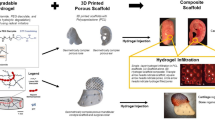Summary
No ideal dural grafting material is currently available. Many materials have been evaluated in this role, and for many neurosurgeons cadaveric human lyophilized dura has been popular. Recently this material has been putatively associated with Creutzfeldt-Jakob disease.
In this study we compared three degradable materials, collagen vicryl (Bovine collagen coated vicryl mesh), Zenoderm (Porcine dermis) and Lyodura (Lyophilized human cadaveric dura) as dural substitutes. In an experimental model using the New Zealand White Rabbit the materials were implanted into dural defects of dimensions 1.7 cm by 1 cm. In the control group the dura was not repaired. In total 47 animals were used and sacrificed at time intervals of 2, 4, 8, 12, and 24 weeks. On gross examination the collagen vicryl produced few adhesions to the cerebral cortex and was replaced by a neomembrane which showed good union with the host dura. In the control group no new layer was formed and there were severe cortical adhesions. Zenoderm and Lyodura remained undegraded and produced more adherence to the cerebral cortex than the collagen vicryl implant. The histological examination showed collagen vicryl to support ingrowth of fibroblasts and the production of a new collagen layer which by 3 months resembled the original host dura. The inflammatory response to the implant did not persist after 3 months. The other substitutes were revitalized by host cells but remained undegraded at 6 months with ingrowth of woven bone and persistence of inflammatory and foreign body response. The results show collagen vicryl to be a suitable dural substitute with potential advantages over other currently used degradable materials, and should be evaluated more fully, both in laboratory studies and clinically.
Similar content being viewed by others
References
Battista F (1949) Collagen repair of bone and dural defects. Can J Res 27: 94
Cone WV, Pudenz RH, Odom RL (1942) An experimental study of the prevention of meningocerebral adhesions. Trans Amer Neurol Assoc 15: 117–120
Collins RL, Christiansen D (1991) Use of collagen film as a dural substitute. Preliminary animal studies. J Biomedical Mater Res 25: 267–276
George B (1989) Materials for the repair of cranial osteodural defects. Neurochirurgie 35(3): 145–151
Glaser MA, Themes CH (1938) Dural defects. How important is their surgical repair. An experimental and clinical study upon heteroplastic and autoplastic dural grafts. Calif West Med 48: 163–166
Gorham SD, Monsour MJ, Scott R (1987) The in vitro testing of collagen vicryl composite film together with candidate suture material for use in urinary tract surgery. Urol Res 15: 53–59
Jannetta PJ, Whayne TF (1965) Formaldehyde treated regenerated collagen film as a substitute for dura mater. Surg Forum 16: 435–437
Keener EB (1959) An experimental study of the reactions of dura mater to wounding and loss of substance. J Neurosurg 16: 424–447
Kline DG (1965) Dural replacement with resorbable collagen. Arch Surg 91: 924–929
Maurer PK, MacDonald JV (1985) Vicryl (Polyglactin 910) mesh as a dural substitute. J Neurosurg 63: 448–452
Mohammed R, Monsour MJ, Gorham SD, French DA, Scott R (1987) The use of a biodegradable collagen n/vicryl composite membrane to repair partial nephrectomy on rabbits. Urol Res 15: 239–242
Penfield W (1924) Meningocerebral adhesions. A histological study of the results of cerebral incision and cranioplasty. Surg Gynecol Obstet 39: 803–810
Penfield W (1936) Epilepsy and surgical therapy. Arch Neurol Psychiatry 36: 449–484
Penfield W (1942) Discussion of Coneet al. Trans Am Neurol Assoc 16: 120
Penar PL, Prichard JW (1987) Jakob Creutzfeldt disease associated with cadaveric dura. J Neurosurg 67: 149–150
Sayed MY, Harvey SC (1923) The regeneration of the meninges. The dura mater. Ann Surg 77: 129–141
Scott R, Mohammed R, Gorham S (1988) The evolution of a biodegradable membrane for use in Urological surgery. Br J Urol 62: 26–31
Trotter W (1924) Sensibility of the skin in relation to neurological theory. Lancet 1: 1252–1256
Author information
Authors and Affiliations
Rights and permissions
About this article
Cite this article
Meddings, N., Scott, R., Bullock, R. et al. Collagen vicryl — A new dural prosthesis. Acta neurochir 117, 53–58 (1992). https://doi.org/10.1007/BF01400636
Issue Date:
DOI: https://doi.org/10.1007/BF01400636




